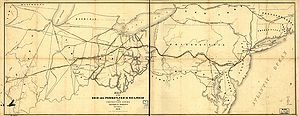Pittsburgh, Fort Wayne and Chicago Railway
This article has multiple issues. Please help improve it or discuss these issues on the talk page. (Learn how and when to remove these template messages)
|
 | |
| Overview | |
|---|---|
| Locale | standard gauge |
The Pittsburgh, Fort Wayne and Chicago Railway was a major part of the
History

The Ohio and Pennsylvania Railroad was chartered in

Work began on August 16, 1854, on the
The Ohio and Indiana Railroad was chartered in Ohio on March 26, 1850, and in Indiana on January 15, 1851, to extend the line west to Fort Wayne, Indiana. It was organized July 4, 1850, and work began in February 1852. Some of the capital was gained from a merger with the Great Western Railroad of Ohio in 1851. On August 26, 1853, the line opened from Crestline west to Bucyrus, and a continuation west to Forest opened in early January 1854. On June 10 the line opened west to Delphos, and on October 31 the full line to Fort Wayne was completed, opening the next day.
The Fort Wayne and Chicago Railroad was chartered in
On July 26, 1856, the Pittsburgh, Fort Wayne and Chicago Rail Road was formed as a consolidation of the Fort Wayne and Chicago, Ohio and Indiana, and Ohio and Pennsylvania Railroads. Extensions opened west to
From the early days, the
On July 1, 1859, the PFW&C defaulted on its debts, and was sold at foreclosure on October 24, 1861. It was reorganized as the Pittsburgh, Fort Wayne and Chicago Railway February 26, 1862.
On July 1, 1865, the PFW&C leased the New Castle and Beaver Valley Railroad, giving it a branch from Homewood, Pennsylvania north to New Castle. The Lawrence Railroad, branching west from Lawrence Junction on the NC&BV to Youngstown, Ohio, was leased on June 27, 1869. On June 1, 1887, the Lawrence Railroad became part of the Youngstown, Lawrence and Pittsburgh Railroad, which on August 1 merged into the PRR's Pittsburgh, Youngstown and Ashtabula Railroad, and on January 9, 1906, that merged with the New Castle and Beaver Valley to form the Pittsburgh, Youngstown and Ashtabula Railway, still leased to the PRR.
The PFW&C bought the Cleveland, Zanesville and Cincinnati Railroad by deed on July 1, 1865, making it its Akron Branch. The line ran from Hudson, Ohio, on the Cleveland and Pittsburgh Railroad south through Akron, crossing the PFW&C at Orrville and continuing to Millersburg. In 1868 a short 3.5 mile (5.5 km) extension to the south was built, and on November 4, 1869, the PFW&C sold the line to the Pittsburgh, Mt. Vernon, Columbus and London Railroad. That company later became part of the PRR's Cleveland, Akron and Cincinnati Railway.
On May 22, 1869, the PFW&C leased the Massillon and Cleveland Railroad, giving it a short branch from Massillon north to the Akron Branch at Clinton.
On July 1, 1869, the PRR leased the PFW&C and began operating it directly, but on April 1, 1871, the PFW&C was transferred to the newly formed
Operation was transferred back to the Pennsylvania Railroad from the Pennsylvania Company on January 1, 1918.

On February 1, 1968, the PRR was merged into
With the August 22, 1998, breakup of Conrail, the line was split at
At the western end of the route, the original PFW&C line has been abandoned from Buffington (an area of far northwestern
On August 1, 2004, the
References
Citations
- ^ Wilson, Erasmus, ed. (1898). Standard History of Pittsburg, Pennsylvania. Chicago: H.R. Cornell & Co. p. 138.
General references
- Railroad History Database
- PRR Chronology
- Corporate Genealogy - Pittsburgh, Ft. Wayne & Chicago
- Pennsylvania Railroad Company Inspection of Physical Property By Board of Directors November 10-11-12, 1948
- Surface Transportation Board - Central Railroad Company of Indianapolis--Lease and Operation Exemption--CSX Transportation, Inc.
- Arrivals & Departures, Trains September 1994
